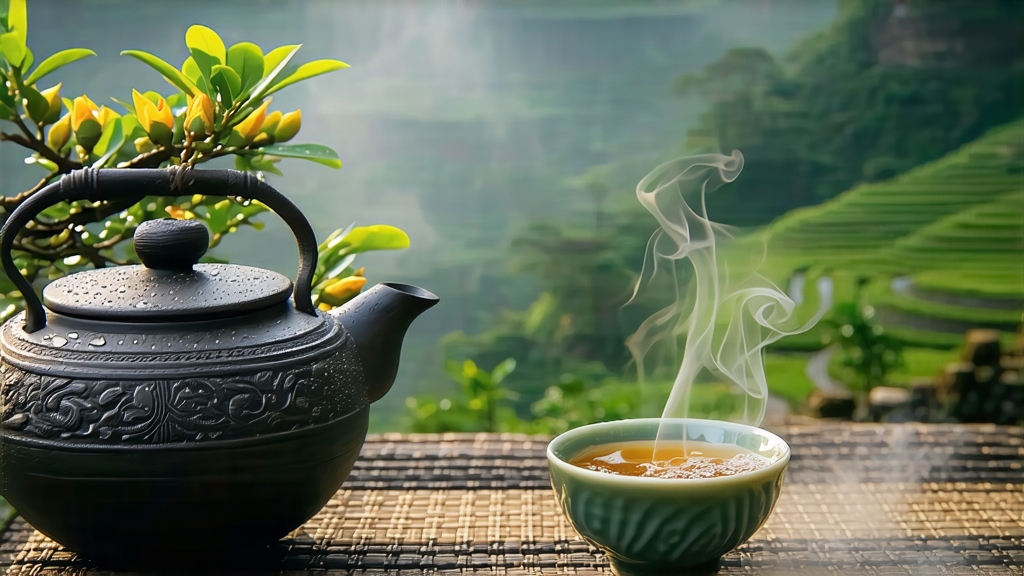
High above the busy Sichuan basin, where the Tibetan Plateau begins its tumble toward the Yangtze, lies Meng Ding Mountain, a ridge so often draped in cloud that local poets call it “the land where sky keeps its secrets.” At elevations between 800 and 1 400 m, the mountain traps moist monsoon air against evergreen forests, creating a natural greenhouse of drifting mist, short sunbursts, and cool nights. In this amphitheatre of moisture and shade grow the small-leaf tea trees whose earliest spring buds become Meng Ding Huang Ya—Meng Ding Yellow Bud—China’s most storied yellow tea and once the first tea to greet the emperor each year.
A history written in mist and tribute
Tea scholars still debate whether yellow tea as a class was born in the Tang (618-907) or Song (960-1279) dynasty, but court chronicles agree on one point: by the early Tang, monks at the Ganlu Temple on Meng Ding were already presenting tiny bundles of “yellow sprouts” to the throne. The name “yellow” originally described the pale straw colour of the finished leaf, yet it soon acquired political resonance—yellow was the imperial hue. During the Song, an edict required the entire first flush to be rushed 1 500 km to Kaifeng in bamboo-lined chests cushioned with silk. Caravans changed horses every 20 km; speed mattered because the bud’s subtle fragrance was believed to fade within days. The Ming dynasty (1368-1644) refined the picking standard to “one bud, just opened, no leaf unfurled,” and Qing emperors granted the tea the rare prefix gong—tribute—so that “Gong Huang Ya” entered the lexicon of luxury alongside jade and palace porcelain. When the last imperial court fell in 1911, the tribute system collapsed, and Meng Ding Huang Ya drifted into obscurity, surviving only through the devotion of temple monks and a handful of mountain families. Its renaissance began in 1959 when Chinese tea scientists, combing ancient texts for lost crafts, persuaded the grandchildren of the final tribute makers to recreate the process. Today the tea is protected under China’s Geographic Indication scheme, and fewer than 3 000 kg of authentic Meng Ding Huang Ya reach the market each year.
From 30 000 buds to one kilogram
The raw material is a local cultivar known as “Meng Ding small-leaf species,” a shrub whose leaves accumulate more theanine and less catechin than the broad-leaf varieties used for pu-erh. Picking begins in mid-March, when morning temperatures hover around 10 °C and dew still beads on the bud’s downy surface. Pluckers work in pairs, one clipping, one collecting, singing short rhythmic couplets that keep fingers moving at the required speed: a skilled woman can gather 600 pristine buds per hour, yet 30 000 are needed for a single kilogram of finished tea. The harvest window lasts only ten days; if the bud grows into a leaf, the raw material is re-directed to green-tea lines.
The secret of “sealed yellowing”
What transforms a green bud into yellow tea is a step called men huang—literally “sealed yellowing.” After picking, the buds are spread 2 cm thick on bamboo trays and withered for 90 minutes in drifting mountain air. Next comes a 3-minute sha qing (kill-green) in woks heated to 160 °C; the goal is not full de-enzyming but a gentle pausing of oxidation so that about 15 % of the leaf’s polyphenol oxidase remains active. While still warm, the buds are wrapped in thick cotton cloth and placed inside a pine-lined wooden box. For the next 48 hours the box is opened every four hours to release trapped carbon dioxide, re-wrap, and re-stack—a ritual repeated twelve times. During these cycles chlorophyll slowly degrades, catechins dimerise into softer theaflavins, and a hint of Maillard sweetness emerges. The leaf colour shifts from jade to pale gold, and the aroma moves from fresh pea to steamed chestnut. Finally the buds are given a low-temperature bake at 55 °C for two hours to fix the flavour, then hand-sorted to remove any broken tips. The entire process consumes five days, four times longer than typical green tea, which explains both the rarity and the price.
Leaf, water, breath: brewing